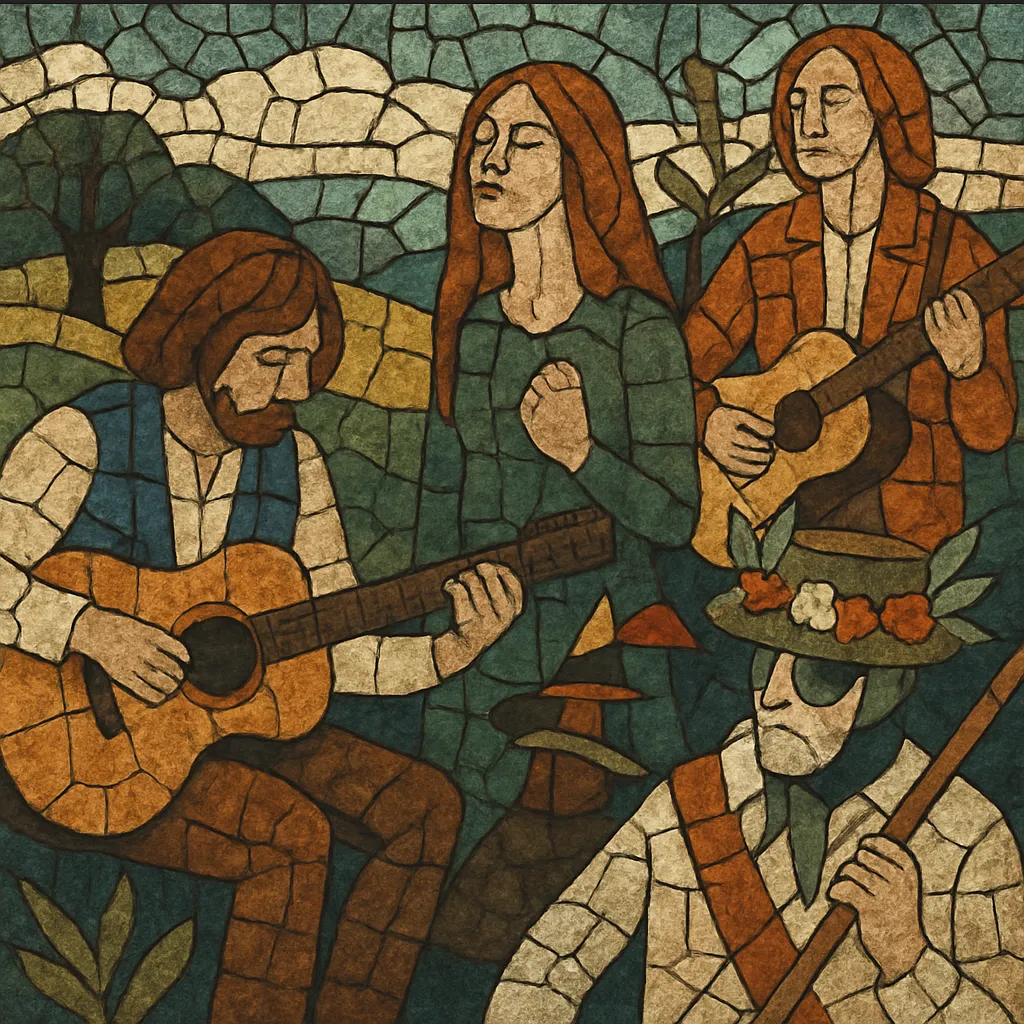British folk rock fuses the melodies, modes, and narratives of traditional music from the British Isles with the amplified rhythm section and songcraft of rock.
Characterized by electric arrangements of ballads, jigs, and reels, the style preserves modal folk melodies (often Dorian and Mixolydian) while introducing drum kit backbeats, bass guitar foundations, and electric/steel-string guitar textures. Fiddle, mandolin, concertina, whistle, and later the octave mandolin/bouzouki sit alongside rock instrumentation, creating a sound that is earthy yet powerful.
The genre came into focus at the turn of the 1970s, most famously with Fairport Convention’s Liege & Lief, which set a template for electrified versions of Child Ballads and tune sets. British folk rock balances storytelling steeped in history and myth with rock dynamics, delivering music that can be both dance-driven and contemplative.
British folk rock emerged when UK musicians, inspired by American folk rock (e.g., The Byrds and Dylan’s electric turn) and the postwar British folk revival, began electrifying local traditional repertoire. Bands such as Fairport Convention and Pentangle initially drew from contemporary folk and psychedelic rock, then turned decisively toward English, Scottish, and Irish traditional songs and dance tunes.
Fairport Convention’s 1969 album "Liege & Lief" is widely cited as the watershed moment, establishing the practice of arranging Child Ballads (e.g., "Matty Groves," "Tam Lin") with a rock rhythm section. Steeleye Span took a more explicitly tradition-forward approach with tight vocal harmony and prominent fiddle, achieving mainstream success in the early to mid-1970s. Pentangle brought jazz sophistication and intricate acoustic interplay. Around them, The Albion Band, Fotheringay, Lindisfarne, and Strawbs broadened the palette—some leaning pastoral, others more pop- or prog-adjacent—while maintaining a core commitment to traditional source material.
As the decade turned, artists explored hybrid routes: Jethro Tull folded British folk motifs into a progressive rock framework, while Oysterband pushed a more contemporary, politically aware sound. Festival circuits (e.g., Cambridge Folk Festival) and regional club networks sustained a scene that oscillated between acoustic and electric expressions, keeping traditional repertoire in circulation while encouraging new songwriting in a folk idiom.
Subsequent waves of artists revisited the template with modern production and indie sensibilities, influencing and overlapping with progressive folk, indie folk, and the broader Celtic rock movement. The genre’s DNA—modal melody, story-ballad narrative, and the dance energy of reels and jigs—continues to shape everything from Celtic punk to folk metal, ensuring its enduring presence in British and global roots-rock landscapes.
Combine a rock rhythm section (drum kit with a steady backbeat, electric bass, electric and/or steel-string acoustic guitars) with traditional instruments (fiddle, mandolin, concertina, whistle, banjo, harmonium; optionally bouzouki/octave mandolin). Aim for interplay where the fiddle or mandolin can carry the tune like a lead guitar.
Alternate between song forms and dance tunes. For reels, use driving 4/4 at 110–140 BPM with a straight, propulsive feel. For jigs, adopt 6/8 at ~100–120 BPM with a lilting, two-beat swing (ONE‑and‑a TWO‑and‑a). Employ tambourine or snare with light ghost notes to mimic traditional percussion; bodhrán can be used tastefully where appropriate.
Favor modal centers (Dorian and Mixolydian are common), drones, and pedal tones. Guitarists can use DADGAD, dropped D, or capoed shapes to emphasize open-string resonance. Chord movement often cycles around I–bVII–IV (Mixolydian) or i–VII–VI (Dorian). Keep melodies prominent and ornamented (fiddle/whistle cuts, rolls, and slides) and let harmony vocals support the tune without over-chromatizing.
Introduce a tune or ballad with a sparse drone or fingerpicked guitar, then build to full-band sections. Interleave vocal verses with instrumental breaks that set jigs or reels in the same key/mode. Use dynamic swells—quiet storytelling into climactic ensemble passages—to mirror ballad narratives. Fiddle double-stops, mandolin tremolo, and rhythmic guitar chug help lock the band.
Draw from traditional ballads, historical events, pastoral imagery, and folklore. Story-first writing, clear diction, and layered harmony singing are hallmarks. When writing originals, mirror the cadence and narrative arc of traditional songs, maintaining a timeless, place-rooted tone.
Aim for an organic, room-forward sound with minimal overdrive on guitars (save heavier distortion for dramatic peaks). Prioritize the acoustic instruments in the mix; let bass and kick provide steady lift without overpowering the tune-led top line.


